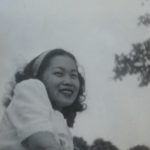- Marion in Washington D.C. soon after the end of World War II.
- Photo of Latin Club from the Excelsior Union High School yearbook, 1940. Marion, age 16, far left of the photo, bottom row.
“Marion Chieko Imamoto.” As I typed my grandmother’s name into the search bar of Ancestry.com and pressed enter, I felt a twinge of discomfort. It seemed so unnatural to search for information about her in such an impersonal manner; normally, I would just give her a call or drop by her house for dinner. Instead, I scrolled through the results: an index documenting her birth in Alameda, California in November 1923; a record of her marriage to my grandfather in 1951 at age 27. Census records from the 1930s and 1940s informed me that at age 6 she lived on a farm in Anaheim with her mother and sisters, and at age 16 she was a student living in Garden Grove.
It has been about a year and a half since my grandmother passed. She was 94 years old. With my birthday approaching, I found myself looking forward to a call from her that I knew I would never receive. Instead, I searched for any piece of her I could find. My grandmother and her immediate family were subject to the forced removal and incarceration of Japanese Americans during World War II, and final accountability rosters recording her parents arrival in Jerome, AR and later departure from Rohwer, AR, documented this tragedy as a cold list of names, dates, and family numbers, reducing the identity of the Imamotos and countless other families of Japanese descent to a few digits. As I read through them, I heard in my head the quiet and subdued tone of my grandmother’s normally cheerful voice as she described being separated from her parents immediately after Pearl Harbor, forced from her home in Norwalk, living in a horse stall in Santa Anita Racetrack, and eventually reuniting with her parents in camp. Looking back, I wish I had asked her more questions.
From the census, draft records, and final accountability reports from camp, I pieced together the stories she had told me about her family and their experiences during the war into a more coherent picture of her life. I learned that my great grandfather, Zenichi Imamoto, immigrated to the United States in 1907, attended college for 2 years, and worked as a bookkeeper in the export industry before becoming a teacher. My great grandmother, Yoshiko Iwamasa, was a picture bride brave enough to marry a stranger in the US in order to escape the fate of becoming a silkworm farmer’s wife. In 1918 at the age of 20, she immigrated to America to start a new life and family. After Pearl Harbor, Zenichi and Yoshiko were both arrested by the FBI and imprisoned at internment camps run by the DOJ as the government feared that their occupations as teachers meant they were a threat to US national security. The couple was forced to leave their four daughters behind until the family was eventually reunited at the concentration camp in Jerome, Arkansas, in 1944. I noted that my great-grandfather’s handwriting on his draft card, rather blocky and written in all-caps, was similar to my father’s and not at all like the neat and delicate lettering my grandmother had used in my birthday cards. After the war, my grandmother moved with her family to Washington, D.C. before returning to California and attending UC Berkeley, where she met my grandfather. They were married in 1951, and my father was born 11 years later.
I wonder how my grandmother felt when the FBI knocked on the door of her family home, leaving her and her sisters to fend for themselves without the guidance of their mother and father. I wondered what it was like for her to rejoin society after being incarcerated in Jerome and come home to a place that continued to show hostility to Japanese Americans. And I wonder what thoughts crossed her mind when the US government issued an official apology to the Japanese American community and acknowledged their wrongdoing in incarcerating 120,000 persons of Japanese descent. Unfortunately, it is too late to ask her.
In the midst of my “what ifs”, I came across a high school yearbook entry from 1940 that matched my grandmother’s name. As I pulled up the accompanying picture, I immediately noticed a young woman in a school uniform with short dark hair, her hands behind her back and head tilted slightly to the left. I could tell it was my grandmother before I even saw the shy smile on her face that I knew so well. Somehow, seeing this photo of her as a young woman with her whole life ahead of her brought me some sort of comfort.
My grandma was so much more than a name in the census. But these documents helped me place her stories within the context of American history as well as fill in some of the details that faded from her memory as she grew older. Most strikingly, what I learned from these records and stories just confirms what I knew about my grandmother already; that behind the vibrant and sweet smile was a smart, independent person who faced countless hardships but never gave up her strength.

About the author:
Catie Sakurai is a 2019 Nikkei Community Intern at the National Japanese American Historical Society. A Sacramento native, Sakurai majored in Physiology and Neuroscience and minored in Bioethics at the University of California, San Diego. Her interests include reproductive healthcare rights, responsibility and mental health, research ethics, and music composition.



